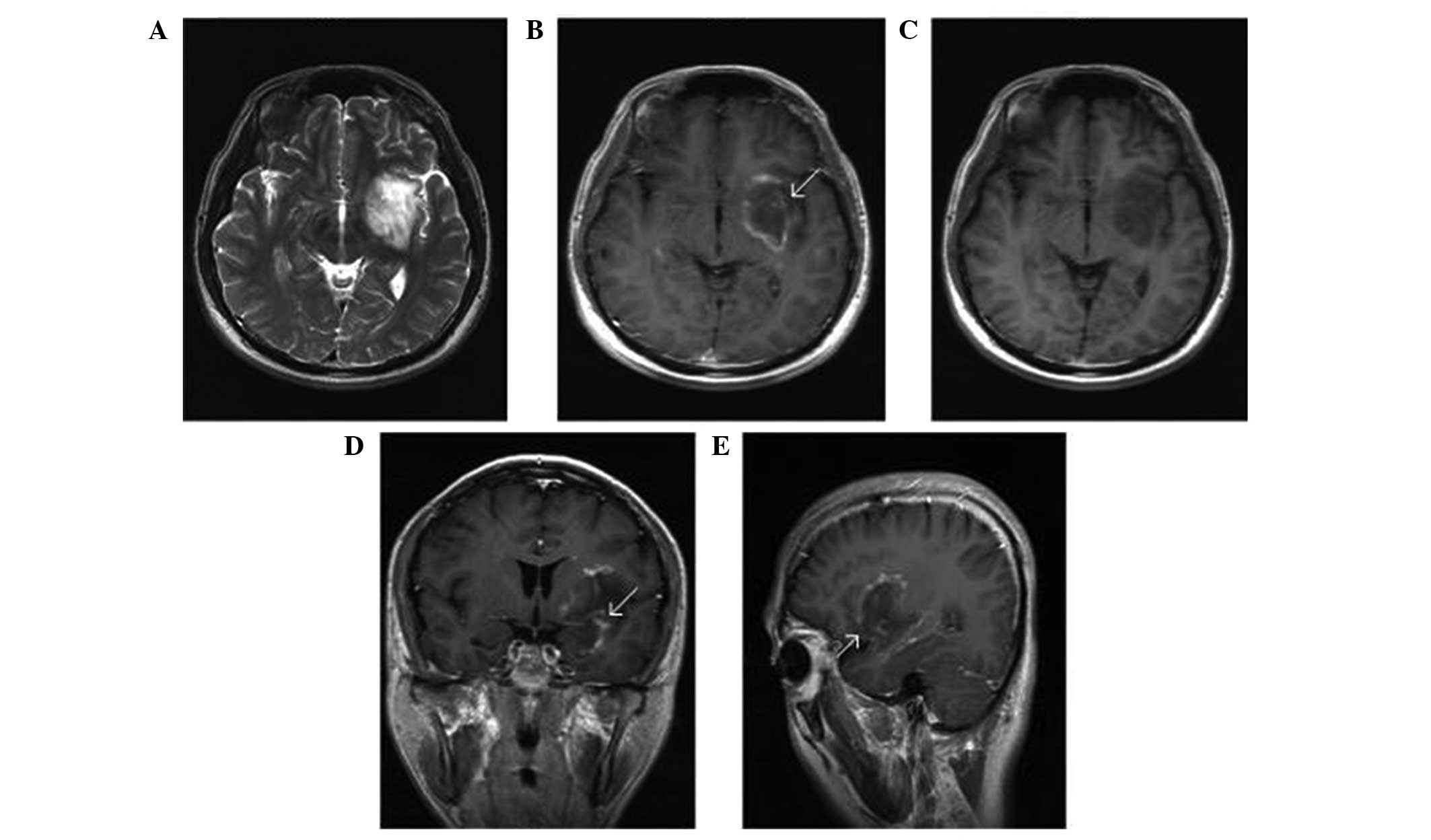|
1
|
Love S: Demyelinating diseases. J Clin
Pathol. 59:1151–1159. 2006. View Article : Google Scholar : PubMed/NCBI
|
|
2
|
Barkhof F, Rocca M, Francis G, et al:
Validation of diagnostic magnetic resonance imaging criteria for
multiple sclerosis and response to interferon beta-1a. Ann Neurol.
53:718–724. 2003. View Article : Google Scholar : PubMed/NCBI
|
|
3
|
Triulzi F and Scotti G: Differential
diagnosis of multiple sclerosis: contribution of magnetic resonance
techniques. J Neurol Neurosurg Psychiatry. 64 (Suppl 1):S6–S14.
1998.PubMed/NCBI
|
|
4
|
Masdeu JC, Quinto C, Olivera C, Tenner M,
Leslie D and Visintainer P: Open-ring imaging sign: Highly specific
for atypical brain demyelination. Neurology. 54:1427–1433. 2000.
View Article : Google Scholar : PubMed/NCBI
|
|
5
|
Klawiter EC, Benzinger T, Roy A, Naismith
RT, Parks BJ and Cross AH: Spinal cord ring enhancement in multiple
sclerosis. Arch Neurol. 67:1395–1398. 2010. View Article : Google Scholar : PubMed/NCBI
|
|
6
|
Di Patre PL, Castillo V, Delavelle J,
Vuillemoz S, Picard F and Landis T: ‘Tumor-mimicking’ multiple
sclerosis. Clin Neuropathol. 22:235–239. 2003.PubMed/NCBI
|
|
7
|
Dagher AP and Smirniotopoulos J:
Tumefactive demyelinating lesions. Neuroradiology. 38:560–565.
1996. View Article : Google Scholar : PubMed/NCBI
|
|
8
|
Lucchinetti CF, Gavrilova RH, Metz I, et
al: Clinical and radiographic spectrum of pathologically confirmed
tumefactive multiple sclerosis. Brain. 131:1759–1775. 2008.
View Article : Google Scholar : PubMed/NCBI
|
|
9
|
van der Velden M, Bots GT and Endtz LJ:
Cranial CT in multiple sclerosis showing a mass effect. Surg
Neurol. 12:307–310. 1979.PubMed/NCBI
|
|
10
|
Wurm G, Parsaei B, Silye R and Fellner FA:
Distinct supratentorial lesions mimicking cerebral gliomas. Acta
Neurochir (Wien). 146:19–26. 2004. View Article : Google Scholar : PubMed/NCBI
|
|
11
|
Iwamoto K, Oka H, Utsuki S, Ozawa T and
Fujii K: Late-onset multiple sclerosis mimicking brain tumor: A
case report. Brain Tumor Pathol. 21:83–86. 2004. View Article : Google Scholar : PubMed/NCBI
|
|
12
|
Zagzag D, Miller DC, Kleinman GM, Abati A,
Donnenfeld H and Budzilovich GN: Demyelinating disease versus tumor
in surgical neuropathology. Clues to a correct pathological
diagnosis. Am J Surg Pathol. 17:537–545. 1993. View Article : Google Scholar : PubMed/NCBI
|
|
13
|
Peterson K, Rosenblum MK, Powers JM,
Alvord E, Walker RW and Posner JB: Effect of brain irradiation on
demyelinating lesions. Neurology. 43:2105–2112. 1993. View Article : Google Scholar : PubMed/NCBI
|
|
14
|
Hunter SB, Ballinger WE Jr and Rubin JJ:
Multiple sclerosis mimicking primary brain tumor. Arch Pathol Lab
Med. 111:464–468. 1987.PubMed/NCBI
|
|
15
|
Lucchinetti CF, Gavrilova RH, Metz I,
Parisi JE, Scheithauer BW, Weigand S, et al: Clinical and
radiographic spectrum of pathologically confirmed tumefactive
multiple sclerosis. Brain. 131:1759–1775. 2008. View Article : Google Scholar : PubMed/NCBI
|
|
16
|
Crooks V, Waller S, Smith T and Hahn TJ:
The use of the Karnofsky Performance Scale in determining outcomes
and risk in geriatric outpatients. J Gerontol. 46:M139–M144. 1991.
View Article : Google Scholar : PubMed/NCBI
|
|
17
|
Comi G: Mutiple sclerosis: Pseudotumoral
forms. Neurol Sci. 25 (Suppl 4):S374–S379. 2004. View Article : Google Scholar : PubMed/NCBI
|
|
18
|
Mitha AP, Scott JN, George D, Hanson A,
MacRae ME and Bell RB: Tumefactive demyelinating lesions. Can J
Neurol Sci. 34:362–364. 2007. View Article : Google Scholar : PubMed/NCBI
|
|
19
|
Given CA II, Stevens BS and Lee C: The MRI
appearance of tumefactive demyelinating lesions. AJR Am J
Roentgenol. 182:195–199. 2004. View Article : Google Scholar : PubMed/NCBI
|
|
20
|
He J, Grossman RI, Ge Y and Mannon LJ:
Enhancing patterns in multiple sclerosis: evolution and
persistence. AJNR Am J Neuroradiol. 22:664–669. 2001.PubMed/NCBI
|
|
21
|
Kim DS, Na DG, Kim KH, et al:
Distinguishing tumefactive demyelinating lesions from glioma or
central nervous system lymphoma: Added value of unenhanced CT
compared with conventional contrast-enhanced MR Imaging. Radiology.
251:467–475. 2009. View Article : Google Scholar : PubMed/NCBI
|
|
22
|
Enzinger C, Strasser-Fuchs S, Ropele S, et
al: Tumefactive demyelinating lesions: Conventional and advanced
magnetic resonance imaging. Mult Scler. 11:135–139. 2005.
View Article : Google Scholar : PubMed/NCBI
|
|
23
|
Cha S, Pierce S, Knopp EA, et al: Dynamic
contrast-enhanced T2-weighted MR imaging of tumefactive
demyelinating lesions. AJNR Am J Neuroradiol. 22:1109–1116.
2001.PubMed/NCBI
|
|
24
|
Weinshenker BG: Therapeutic plasma
exchange for acute inflammatory demyelinating syndromes of the
central nervous system. J Clin Apheresis. 14:144–148. 1999.
View Article : Google Scholar : PubMed/NCBI
|
|
25
|
Keegan M, Pineda AA, McClelland RL, Darby
CH, Rodriguez M and Weinshenker BG: Plasma exchange for severe
attacks of CNS demyelination: predictors of response. Neurology.
58:143–146. 2002. View Article : Google Scholar : PubMed/NCBI
|
|
26
|
Champs Study Group, . Interferon beta-1a
for optic neuritis patients at high risk for multiple sclerosis. Am
J Ophthalmol. 132:463–471. 2001. View Article : Google Scholar : PubMed/NCBI
|
|
27
|
Confavreux C and Vukusic S: Natural
history of multiple sclerosis: implications for counselling and
therapy. Curr Opin Neurol. 15:257–266. 2002. View Article : Google Scholar : PubMed/NCBI
|















